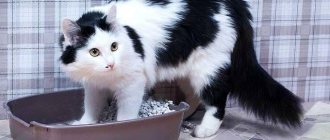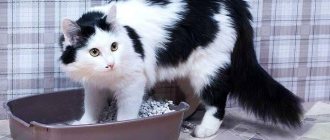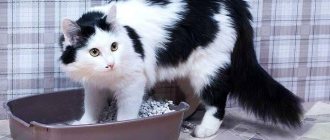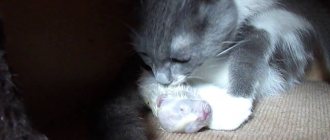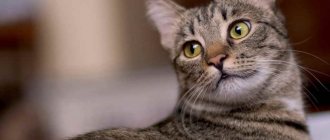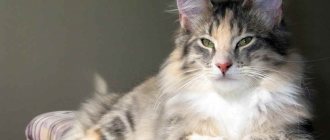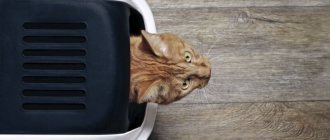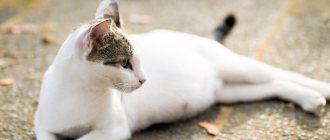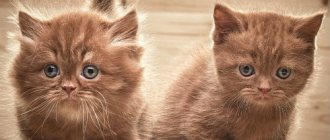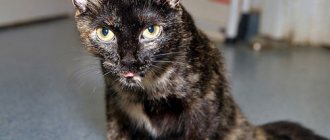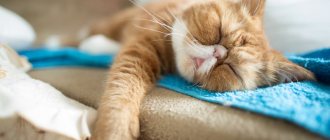When bringing a cat into the house, people should be prepared for the fact that it will have to be toilet trained. However, cats do not always fulfill their needs the way their owner would like. But the reason is not always the stubbornness of the animal, because it may simply have problems with urination or defecation.
To prevent difficulties in managing your needs from leading to even more serious problems, you need to contact a veterinarian in time to help find out the root cause. If a cat does not go to the toilet for more than a day, this can lead to blood problems and kidney failure. In this article, you can learn about the main reasons why your pet may have difficulty going to the toilet.
You can learn a lot about your cat's health from her feces. In most cats, the frequency of elimination is at least once (1-2 times is considered normal) times a day. Typically, the stool should look well-formed and brown in color, but it may look slightly different. If your cat defecates less frequently and has difficulty doing so, she is constipated.
Free consultation Moscow
+7(495)162-70-70
Problems with going to the toilet in general
Typically, kittens at the age of one month can go to the toilet to relieve their great needs from 3 to 5-6 times a day. The main factors that can cause problems going to the toilet in general include the following:
- The cat's inability to cope with her responsibilities of toilet training her newborn kitten. It is the cat who must ensure that the baby can relieve his natural needs.
- Another cause of problems may be a congenital pathology, for which you should immediately contact a veterinarian.
- A small kitten should transition very smoothly from mother's milk to adult food. If the transition occurred abruptly, then this can cause major hiking problems.
- Stress when changing the environment can also be the reason when a kitten refuses to walk for several days. It is necessary to sound the alarm when adaptation has passed, which is about 5 days, and the problem with the toilet has not been resolved.
Feline megacolon is an intestinal disorder that results in chronic and progressive constipation. The disease may be caused by damage to the nerves of the intestine or impaired functioning of the smooth muscles of the colon.
The size of the stool can increase to the diameter of the colon, which makes it difficult for the resulting stool to pass through the bony canal of the pelvis, which does not increase in size and, as a result, defecation becomes impossible. When this happens, the colon is affected and serious secondary problems can occur.
How can I help the animal?
You should not take any measures on your own to help your cat empty his bowels or bladder. Any medications should only be prescribed by a veterinarian, after determining the cause of urinary or fecal retention.
For example, laxatives should not be given for tumors, adhesions, intestinal obstruction, or the presence of foreign objects in the gastrointestinal tract. Otherwise, such treatment may lead to rupture of internal organs.
If the veterinarian has allowed the use of laxatives, then it is advisable to choose softer ones - Duflac or Vaseline oil. If you have constipation, you should not give your cat castor oil. This oil will cause increased pain and worsening of the condition.
The doctor must prescribe medications that restore intestinal microflora, enemas, anti-inflammatory and painkillers. During treatment, the cat is given more liquid and less dry food. Infusions of medicinal herbs are poured into the animal's mouth.
If a hot bath is needed, the cat is lowered into it only to the level of the heart. In any case, it is better to carry out all procedures, injections and treatment in the clinic. Some pathologies of the urinary tract become chronic. In this case, treatment should be carried out regularly. Herbs are given to the cat over a long period.
Symptoms of feline megacolon
- Straining during bowel movements with little or no stool volume
- Small, hard and dry feces
- Infrequent or complete absence of bowel movements
- A small amount of loose stool with mucus – sometimes with blood – that occurs after prolonged straining before defecation (tenesmus)
- Periodic vomiting
- Lack of appetite
- Depression
- The colon is filled with hard, compacted fecal material
- Swelling around the anus
Prevention
Chronic diseases of the urinary system require careful monitoring. It is important to find a competent doctor who will develop an individual scheme and will thoughtfully adjust it as changes occur. The general approach with one prescription for all in the case of cystitis, urolithiasis and PN is disastrous.
Prevention of exacerbations is comprehensive:
- strictly follow the instructions without experimenting with medications;
- Together with your doctor, choose a diet or medicinal food with mandatory monitoring of blood and urine readings. No salt, fish, fat, excess meat;
- Filtered water should always be available - several bowls throughout the apartment. If the cat does not drink, switch to a semi-liquid diet;
- control the load - the pet should not sleep all the time, but too active games are contraindicated for it;
- avoid overheating, hypothermia, stress, injuries;
- take tests, ultrasound, x-rays every six months.
A filler that responds to changes in urine acidity will help control your pet’s condition. If you suspect a relapse, consult a doctor immediately. With each attack when the cat cannot pee, it will be more difficult to restore the functioning of the genitourinary system, so you should not lead the situation to urinary retention.
Causes of feline megacolon
Behavior and lifestyle
- Foreign material (swallowed bones, swallowed hair)
- Excess fiber in the diet
- Lack of exercise
- Stress (the problem of having several cats, change of environment, hospitalization, moving, dirty litter box)
- Intestinal obstruction
Pain
- Trauma, joint disease, pain as a symptom of disease
Dehydration (insufficient water intake)
And although cats are desert animals by nature, their modern relatives need free access to water for the normal functioning of all body systems. And if for some reason there is a violation of the hydrobalance (for example, with kidney disease), then the water necessary for the formation of feces begins to be absorbed in the colon, as a result of which they form hard and dry.
Metabolic disorders
- Obesity
- Low blood calcium levels
- High levels of parathyroid hormone (important for calcium absorption)
- Low blood potassium levels
- Low levels of thyroid hormone in the blood
Neurological problems
- Paralysis/muscle weakness (intestinal muscles cannot move feces)
Colon obstruction
- Pelvic deformities (eg, healed pelvic fracture after injury)
- Tumor
Idiopathic megacolon
Megacolon can also occur in a cat as a primary condition without an obvious underlying cause. In this disease, a problem develops in the muscles of the colon wall itself, resulting in a progressive inability to contract.
Diagnostics in a veterinary clinic
Urinary retention and its cause are determined on the basis of palpation, ultrasound and x-ray of a congested organ. In addition to bladder enlargement, these tests help diagnose kidney problems, tumors and stones.
Additionally, blood and urine tests are taken from the mustachioed patient. With their help, the causative agent of infection, the type of stones and the level of intoxication of the body are identified.
Emergency care for a cat with constipation.
If your cat has not used the litter box for more than 24 hours or is passing a small amount of feces each day:
- Make sure your cat has free access to water and drinks it.
- Feed her wet canned food.
- Try adding a tablespoon of canned pumpkin to your canned goods.
- If constipation lasts more than 48 hours, your cat needs veterinary attention.
- An alternative to pumpkin is a laxative (such as Metamucil®). Check with your veterinarian for dosage.
- If dietary changes (such as increasing fiber and water intake) do not help, your veterinarian will likely give your cat an enema.
Call a veterinarian Moscow
+7(495)162-70-70
Description
Cats are light-drinking animals.
They go without water for several days, obtaining moisture from urine. They can endure for a long time without visiting the litter box due to stress, unpleasant odor or new litter. But the concentration of urine is constantly growing. Coupled with a sedentary lifestyle, these factors make the urinary system a weak point in cats. The kidneys continuously cleanse the blood of toxins, are responsible for the acid-base balance, participate in metabolism, and perform an endocrine function. A healthy cat pees at least three times a day, getting rid of salts and protein breakdown products. Fresh urine has almost no odor, is light and transparent.
The condition when a cat cannot pee leads to serious consequences for the body:
- urine goes out - intoxication increases;
- water, acid-base balance is disturbed;
- with increasing urine concentration, the walls of the bladder are damaged;
- bacteria are not washed out of the urethra, reproduction leads to ascending infections;
- Within a day, azotemia develops - the accumulation of metabolic products in the blood. This is an emergency condition in which 10% of patients die even in a hospital setting;
There are two options for urinary retention. With kidney failure, urine is not produced. With obstruction, the cat cannot pee due to a “plug” in the ureter, bladder neck or urethra. That is, the cat either has nothing to pee with, or urine cannot come out due to an obstruction. The urethra of cats is wider and shorter, so they are less likely to suffer from blockage than cats.
An adult cat does not relieve itself to a large extent
Adult cats and cats, unlike kittens, can go to the toilet only once a day. The owner should only worry if the animal has not been able to walk for more than 3 days. Common reasons for the absence of bowel movements in adult felines are:
- Incorrect nutrition and incorrect ratio of nutrients. Stool may be retained due to insufficient fluid intake, as well as low fiber intake.
- Moving or having guests can also affect problems with going to the toilet.
- A cat may not go to the toilet if a new animal has appeared in the apartment.
- Cats clean their fur using their tongue, so there is a possibility that hairballs may form in the gastrointestinal tract. Their presence also causes problems with going to the toilet in general.
- Neutered cats usually lead a sedentary lifestyle, which leads to obesity. But obesity itself can lead to problems with bowel movements.
- The age of a cat greatly affects trips to the toilet, since the intestines of an old cat can no longer move feces through the intestines quickly enough.
- If an adult cat has difficulty going to the toilet in general, it is necessary to check its internal organs.
What disorders cause difficulty urinating?
Depending on the existing disorder, urine is completely or partially absent - or it encounters an obstruction at the exit. In the first case, the cause usually lies in renal pathologies, and in the second, in blockage of the urethra due to excitement, trauma, infections and stones.
Sexual arousal
Most often, during sexual hunting, owners complain about the opposite problem - frequent urination in females and leaving marks in males. But excitement also leads to enlargement of the gonads with subsequent compression of the urethra.
Injuries
After an accident and falling from a height, a cat can damage its internal organs. In this case, the delay is explained by the loss of their functionality, and the presence of blood in the urine is due to internal bleeding.
Cystitis and other bladder diseases
The most common reason why a cat cannot pee is cystitis. Inflammation in the bladder is usually caused by bacteria that enter there directly or from neighboring organs. The pathology is accompanied by severe pain, increased urge and a gradual reduction in the volume of fluid to a few drops.
Advanced cystitis is often complicated by urethritis. With this disorder, the inflammatory process covers the urethra. It can be diagnosed by purulent discharge and a strong odor of acetone or ammonia from the pet's skin.
Urolithiasis disease
When there are too many stones in the ureter, a blockage occurs. Every attempt to urinate is accompanied by acute pain due to stones that injure the delicate mucous membrane. The blood emerging from numerous wounds turns the urine pink or comes out in separate clots.
“
Read more about urolithiasis in cats
Renal pathologies
Of all the kidney diseases in cats, kidney failure is the most common. It occurs when there is blockage and compression of the urinary tract, a sharp decrease in the amount of blood circulating through the kidneys, and direct dysfunction of the organ. The last case has the most unfavorable prognosis, since damaged kidney cells are not able to recover.
Treatment of constipation in cats
Laxatives
There are many laxatives available now, although many are not licensed specifically for cats.
- Emollient laxatives.
Drugs that help retain fluid in cat stool, thereby making it softer. These laxatives have a weak effect, but can be useful, either alone or in combination with other medications.
- Osmotic laxatives.
They retain water, soften and increase the volume of contents in the cat’s intestines. They are distinguished by their powerful action. Used alone and in combination with other laxatives.
- Stimulant laxatives. Some medications have the effect of stimulating the contraction of the muscles in the walls of the cat's colon, which helps move feces toward the anus. These medications work in a variety of ways and are only safe for short-term use.
Prokinetics
Prokinetics are medications that stimulate the motility of the cat's gastrointestinal tract. Like stimulant laxatives, they help enhance neuromuscular control of colon contractions. Prokinetic agents can be used long-term, usually in combination with other measures to control constipation (eg, lactulose and dietary foods).
Surgical operations
If drug therapy does not provide results in combating constipation in a cat, it is sometimes necessary to perform an operation such as a subtotal colectomy - removal of most of the colon. Although this is a fairly serious operation and your cat will inevitably have diarrhea for some time afterwards, the long-term outcome of the operation is often very good. Most cats adapt gradually and the diarrhea goes away fairly quickly.
Preventing constipation in cats
- Ensuring good hydration
- Diet
- Physical activity
- Use of intermittent emollient laxatives
- Controlling the number of bowel movements per day/week
What to do at home if your cat is constipated
In most cases, it is possible to improve bowel movements with the help of nutritional correction, increased physical activity, massage and laxatives. If fecal retention in a cat is caused by intestinal pathologies or tumor processes, then only surgery will help.
In cases where prolonged constipation is accompanied by vomiting, the cat is given IV drips to prevent dehydration.
Normalization of diet
To help your cat with constipation, you need to change his diet. In the first days after symptoms are detected, it is advisable to switch your pet to liquid food. Food from the human table is completely excluded from the menu - semi-finished products, sweets, foods with added salt and spices, bones.
To loosen stools, you can give a little beef liver daily.
What to include in the diet of a cat with constipation:
- vegetables – pumpkin, spinach, carrots;
- fermented milk products - classic yogurt without additives, kefir, yogurt;
- vegetable oil – no more than 1 teaspoon per day.
It is very important to increase the amount of fluid consumed. The cat should be given purified raw water.
Veterinarians recommend placing several bowls of water in different places in the apartment.
Special feed
Cats that are accustomed to dry industrial formulas are given special food with fiber, vitamins and minerals. They contain plant components, fish oil, and cereals. List of medicinal foods for cats for constipation:
- Royal Canin Fiber Response. Recommended for the treatment and prevention of diseases of the gastrointestinal tract. Duration of use for acute constipation is 1 month, for chronic constipation – up to six months.
- Hills Prescription Diet Feline w/d. Recommended for cats with diabetes, colitis and constipation. Contains a large amount of coarse fibers, which help enhance intestinal motility.
- Eukanuba Renal. Dietary cat food for constipation due to kidney dysfunction. Its difference from others is its low protein and phosphorus content.
Attention! It is very important to feed your cat as recommended by the manufacturer. Do not increase the dosage indicated on the package and do not pour food more than twice a day.
Massage and Vaseline oil
If constipation occurs, you can massage your cat's abdomen and give him Vaseline oil. It is not absorbed in the intestines, but moves along it all the way to the rectum, lubricating its walls and softening the stool.
Vaseline oil helps quite quickly: after 3-4 hours the cat goes to the toilet. The method of application is simple - you need to let the cat drink 1-2 ml from a syringe without a needle. It is advisable to do this in the morning on an empty stomach, then the oil will easily enter the rectum.
Massage helps strengthen intestinal motility. It is done 2-3 times a day for 5 minutes. The cat should not eat an hour before the procedure and 2 hours after it.
Massage technique:
- place the cat on its back on your lap;
- massage the abdominal area clockwise with your fingers.
You can help a kitten in the same way. Although it is usually the mother who massages the babies. She licks their bellies several times a day. This helps kittens go to the toilet regularly.
Laxatives
An easy way to treat constipation in a kitten is to start giving a laxative. It is worth giving preference to safe drugs. The following medications are suitable for cats:
- Duphalac Lactusan. A laxative based on lactulose, which not only softens stool well and promotes its movement, but also improves bowel function. Even a kitten can be given this medicine for constipation; it is absolutely safe.
- Microlax. This is a mini-enema with a solution for rectal administration. The composition contains substances that displace bound water from feces. The drug acts quickly - the urge to have a bowel movement occurs from the first minutes after administration of the solution.
- Normaze. Lactulose-based syrup. Effectively softens stool and promotes easy bowel movements.
Attention! Laxatives can only be given to a cat on the recommendation of a veterinarian. In some cases, their use can harm your pet.
Problems with going to the toilet in small ways
It is very easy for the owner to understand that the cat is having problems going to the toilet in small ways. In such cases, cats begin to behave very noisily. The animal may meow loudly, stomp around the tray, but not sit in it, and they cannot lie on their stomach because of the painful sensations in it. If a cat tries to go into the litter box, but fails, traces of blood and even pus can be found in it. Some of the common reasons why an animal cannot go to bed are:
- A small amount of fluid intake, which leads to the formation of stones.
- Hereditary predisposition, for example, when someone in the cat’s family already had problems with going to the toilet.
- A common reason for the inability to go to the toilet normally is poor nutrition, for example, when the animal does not have enough nutrients in the body or if the owner feeds the animal raw meat and fish.
- Urine can be very poorly excreted in cats that lead a sedentary lifestyle and are overweight.
- A cat may have problems urinating if it has a new owner or has moved to a new place and is under extreme stress.
- When an animal has a pathology of the urinary tract, it is necessary to urgently seek help from a veterinarian; in rare cases, surgical intervention may be required.
- Constant consumption of dry food can cause urolithiasis, so it is very important that your pet has constant access to fresh drinking water.
Special diet
After establishing the reason why the cat cannot pee and carrying out treatment, you should make the right choice of ready-made cat food or change the diet from natural products.
Among industrial cat foods, preference should be given to holistic ones. But the high cost and difficulties in purchasing sometimes become an obstacle for owners. Therefore, they can be replaced with super premium food.
Important! Sometimes owners have a hard time getting their pets to switch to holistic. This is due to the lack of flavor enhancers and flavoring agents that are added to lower class feeds.
In case of urolithiasis, the diet of cats that eat natural food should be adjusted depending on the type of stones. To do this, you need to consult a veterinary nutritionist or attending physician, who will base his recommendations on laboratory data.
| Type of stones | Authorized Products | Prohibited Products |
| Phosphates | rice, buckwheat, oatmeal; | whole milk; |
| boiled beef and rabbit; | hard and fermented milk cheese; | |
| boiled liver | Fish and seafood | |
| Oxolates | boiled carrots, cauliflower; | offal; |
| boiled dietary meat | Fish and seafood; | |
| milk | ||
| Urats | allowed boiled vegetables; | meat and fish broths; |
| lamb, duck, non-lean beef | offal; | |
| lean meat; | ||
| asparagus; | ||
| cauliflower; | ||
| legumes |
For any type of stone, cats can be given pureed baked apples and pears.
Cat sterilization and toilet problems
Sterilization is a fairly quick operation, but it requires a long recovery. In the period after surgery, it is very important to monitor your pet’s sutures, treat them in a timely manner and remove them only by a veterinarian. If during the postoperative period the cat does not go to the toilet, constipation must be ruled out. Urination may be in small quantities, which will be completely unnoticeable to the owner. In order to prevent strong pressure on the abdominal wall, which can lead to suture divergence, you should offer the animal only soft and gentle food.
Sometimes the anesthesia used during surgery negatively affects the animal's condition and can lead to constipation. It is quite easy to understand whether an animal has constipation. At this time, the cat does not want to go to the litter box, meows often, there is no bowel movement, and there is a complete refusal to eat. Even during this period, you can observe how the animal’s tail shakes slightly and the seam may be damaged. If constipation does occur, then you need to contact a veterinarian who will prescribe special medications and a balanced diet. If it is not possible to contact a specialist, you can try to alleviate the animal’s condition with a tablespoon of Vaseline.
Often the cause of urinary retention is the stress that the animal experiences during and after surgery. Also, the blanket can bring them significant discomfort.
In this case, you can carefully remove it, after consulting with a doctor, and then watch to ensure that the cat does not lick the seam area.
Relieving the animal's condition and treatment
The patient's condition is alleviated by inserting a catheter and taking medications. It is also mandatory to prescribe a therapeutic diet that includes a reduced intake of proteins and fats.
Catheterization
In especially severe cases, catheterization is carried out even before ultrasound. With its help, all excess fluid is removed, and the urethra is washed from toxic urine products.
The procedure is carried out under anesthesia, and if large stones are detected, it is combined with urethrostomy - the creation of an additional hole for urine drainage and the subsequent installation of a permanent catheter.
Medication treatment at home
Drugs are selected individually based on the diagnosed cause. Sexual heat is simply waited out or eliminated by castration.
With injuries, everything depends on their severity. This often requires the help of a surgeon. If the problem lies in diseases of the bladder and kidney pathologies, then the mustachioed patient is prescribed:
- antibiotics and antivirals that destroy the infectious agent;
- diuretics, stimulating the outflow of urine;
- anti-inflammatory, suppressing the inflammatory response;
- rehydration solutions that normalize water balance;
- hemostatic agents that improve blood clotting;
- detoxification drips that eliminate the effects of poisoning;
- cardiogenic, stabilizing the heart;
- analgesics and antispasmodics that relieve pain and spasms.
The decision to stop treatment is made by the doctor based on tests. Stopping it too early or reducing the dosage can result in a sharp deterioration in the condition and the emergence of new complications.
Childbirth and problems going to the toilet
Before giving birth, cats begin to prepare their bodies for childbirth. So, just before giving birth, they stop eating a lot or refuse to eat at all, and also begin to go to the toilet more often. After giving birth, a cat may not walk for about 24 hours, and avoid bowel movements for 3 days.
When a cat begins nursing kittens, she loses a lot of fluid, so it is very important to replace lost fluid. If your cat doesn't drink enough water, this can lead to constipation. To help your pet get rid of constipation, you can offer him a small amount of olive oil. If, even after 24 hours after using olive oil, the cat still does not go away, then you should seek help from a specialist.
For any living creature it is very important not only to drink and eat, but also to cope with its natural needs. If your pet does not walk on small or large for a long time, then you should contact a veterinarian. You need to pay attention to the cat already on the second day, if during this time the animal was not noticed urinating. The veterinarian will definitely find out the cause of constipation or problems with urination, and will also ask questions regarding the pet’s diet, drinking regime and how long he has had problems going to the toilet.
Urgent medical care
First aid in a veterinary clinic involves inserting a catheter. Only a professional should insert a catheter, after first flushing the bladder with antiseptics. This operation is painful, so it is performed under general anesthesia. After catheterization, the veterinarian performs a series of tests to find the cause of urinary retention.
Important: you should not insert a catheter often - after this procedure, swelling of the urinary tract occurs. If the doctor sewed in a catheter for several days, you need to keep the cat in a special collar during this time so that it does not injure itself and does not remove the catheter.
